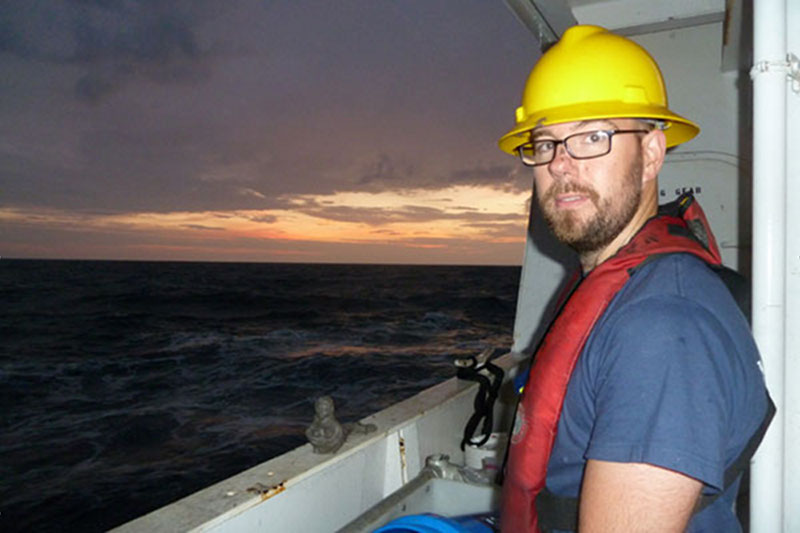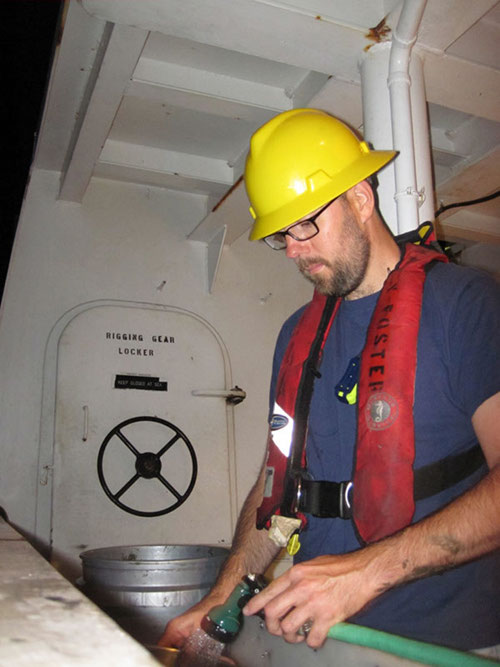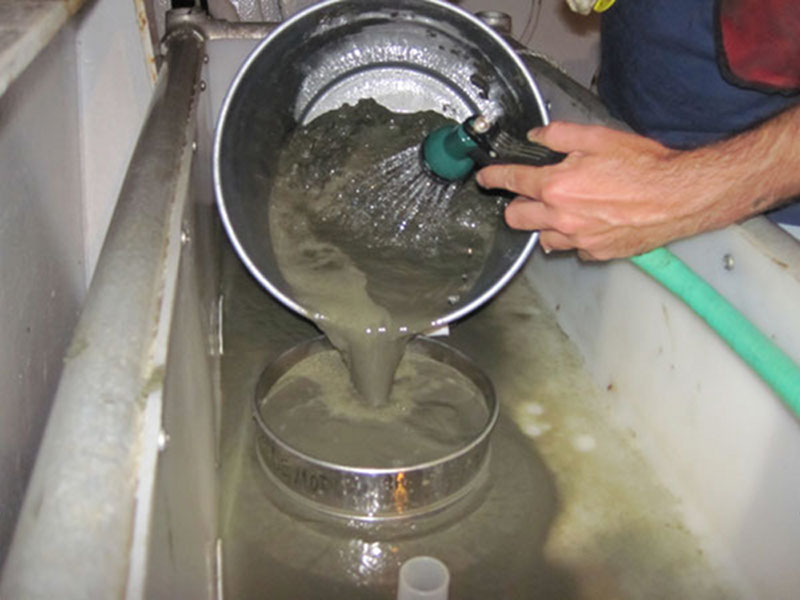
By Craig Robertson - Bangor University, UK
August 22, 2012

Craig Robertson is a Ph.D. candidate from Bangor University in the United Kingdom, who is working closely with Drs. Davies, Duinefeld, Demopoulos, and Mienis on benthic sampling. Image courtesy of E. Hannerman, Deepwater Canyons 2012 Expedition, NOAA-OER/BOEM. Download image (jpg, 66 KB).
I hope to be able to predict, through measurements of physical and biological factors, the likely distributions of hard substrata habitats (namely cold-water coral biotopes) in the Mid-Atlantic Bight (MAB). Ecological niche modelling will allow for the extension of the habitat models which can then be applied to hypotheses testing of canyon habitats, species and adjacent slope communities. My doctoral study aims to assess the eco-hydrodynamic drivers determining faunal patterns and habitat structure in Mid-Atlantic canyons. The project has several constituent research parts and hopes to deliver a complete appraisal of ecological functioning in North East coast canyon systems.

Craig Robertson rinsing the silt from some of the benthic infauna he collected using the Box Corer. Image courtesy of E. Hannerman, Deepwater Canyons 2012 Expedition, NOAA-OER/BOEM. Download image (jpg, 62 KB).
The first phase of the project will examine the physical hydrodynamics in deep Mid-Atlantic Bight (MAB) canyons. Physical parameters of salinity, temperature, suspended particle load, current direction and velocity will be determined and added to the current map of topographical features in the canyons. The model can then be applied to hypothesis testing to illustrate the physical drivers behind substrate heterogeneity, habitat diversity and species distribution in a West Atlantic canyon. This phase will test whether individual MAB canyons exhibit dissimilar hydrodynamic regimes (e.g. tidal flows, turbidity storms and internal waves) and topographic features (e.g. vertical walls, rocky outcrops and large sediment waves) which jointly influence canyon specific patterns of habitat and community assemblages. It will also test whether MAB canyon hard substrata habitats and species (e.g. cold-water corals) experience greater current velocity and turbidity episodes over temporal and spatial scales compared to adjacent habitats, and if these provide species enrichment through increased food supply.

From about 10 cm of mud in the Box Corer, Craig might only collect a few tablespoons of benthic infauna. Image courtesy of E. Hannerman, Deepwater Canyons 2012 Expedition, NOAA-OER/BOEM. Download image (jpg, 69 KB).
The second phase will use sediment characteristics, organic content data from sediment trapping and sediment coring to assess food quality and supply dynamics on soft sediment communities along transects bisecting the entire span of the canyon in collaboration with the Netherlands Institute for Sea Research (NIOZ) colleagues, Drs. Duineveld and Mienes. I hope to determine if infaunal communities exhibit higher species richness and biomass in the canyon compared to adjacent slope communities, as a result of increased availability and higher quality food. Benthic infauna sampling analysis will be partnered with Dr. Demopoulos of USGS.
I also hope to investigate benthic bathymetric zonation and infaunal community trends. Using infaunal sampling across the length of and bisecting the canyon will allow for the determination of bathymetric zones within the canyon system via similarity matrices analysis. Do canyon infauna communities exhibit species endemism within the bathymetric zones in a canyon system? Are hydrodynamics and sedimentary processes, influencing infaunal communities within MAB canyon systems, key drivers in the compression of bathymetric zonation patterns present in a canyon system?